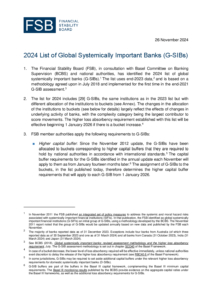Press enquiries:
+41 61 280 8477
[email protected]
Ref: 31/2023
- The Financial Stability Board publishes annual list of global systemically important banks (G-SIBs).
- No banks have been removed or added to the list, with the total number of G‑SIBs remaining at 29.
- Compared with the list of G-SIBs published in 2023, two banks have moved between categories (i.e. buckets): Groupe Crédit Agricole has moved to a higher bucket, corresponding to a higher capital requirement, while Bank of America has moved to a lower bucket, corresponding to a lower capital requirement.
The Financial Stability Board (FSB) today published the 2024 list of global systemically important banks (G-SIBs) using end-2023 data and applying the assessment methodology designed by the Basel Committee on Banking Supervision (BCBS).
The number of banks identified as G-SIBs remains at 29; there were no additions or removals from the list. However, compared with the list of G-SIBs published in 2023, Groupe Crédit Agricole has moved from bucket 1 to bucket 2 (corresponding to a higher capital requirement), while Bank of America has moved from bucket 3 to bucket 2 (corresponding to a lower capital requirement).
FSB member authorities apply the following requirements to G-SIBs:
- Higher capital buffer: The G-SIBs are allocated to buckets corresponding to higher capital buffers that they are required to hold by national authorities in accordance with international standards. The capital buffer requirements established by the 2024 list will be effective beginning 1 January 2026.
- Total Loss-Absorbing Capacity (TLAC): G-SIBs are required to meet the TLAC standard, alongside the regulatory capital requirements set out in the Basel III framework.
- Resolvability: These requirements include group-wide resolution planning and regular resolvability assessments. The resolvability of each G-SIB is reviewed in the FSB Resolvability Assessment Process (RAP) by senior regulators within the firms’ Crisis Management Groups.
- Higher supervisory expectations: These include supervisory expectations for risk management functions, risk data aggregation capabilities, risk governance and internal controls.
The BCBS today published material related to the identification of G-SIBs, including updated denominators used to calculate banks’ scores; the thresholds used to allocate the banks to buckets; and the values of the thirteen high-level indicators of all banks in the assessment sample used in the G-SIB scoring exercise. The BCBS also provides the links to the public disclosures of all banks in the full sample of banks assessed. The BCBS interactive G-SIB dashboard has also been updated to reflect the latest results.
A new list of G-SIBs will next be published in November 2025.
Notes to editors
The requirements for G-SIBs summarised above are “higher” in the sense that they are additional to the minimum standards that apply to all internationally active banks under the Basel Framework. G-SIBs are allocated into buckets based on their systemic importance. The higher the bucket, the greater the additional capital requirement. The bucket approach is defined in paragraphs SCO40.20 to SCO40.22 of the Basel Framework.
The FSB coordinates at the international level the work of national financial authorities and international standard-setting bodies and develops and promotes the implementation of effective regulatory, supervisory, and other financial sector policies in the interest of financial stability. It brings together national authorities responsible for financial stability in 24 countries and jurisdictions, international financial institutions, sector-specific international groupings of regulators and supervisors, and committees of central bank experts. The FSB also conducts outreach with approximately 70 other jurisdictions through its six Regional Consultative Groups.
The FSB is chaired by Klaas Knot, President of De Nederlandsche Bank. The FSB Secretariat is located in Basel, Switzerland and hosted by the Bank for International Settlements.
